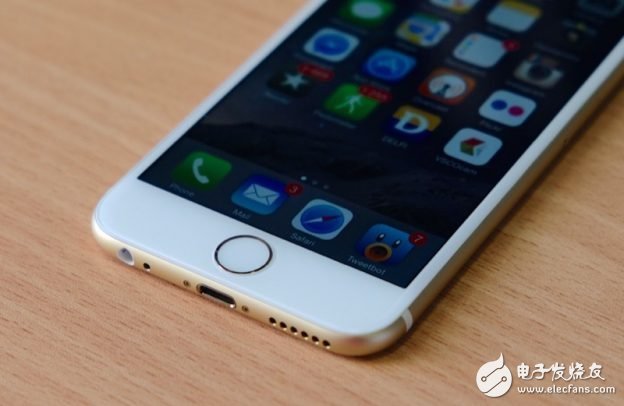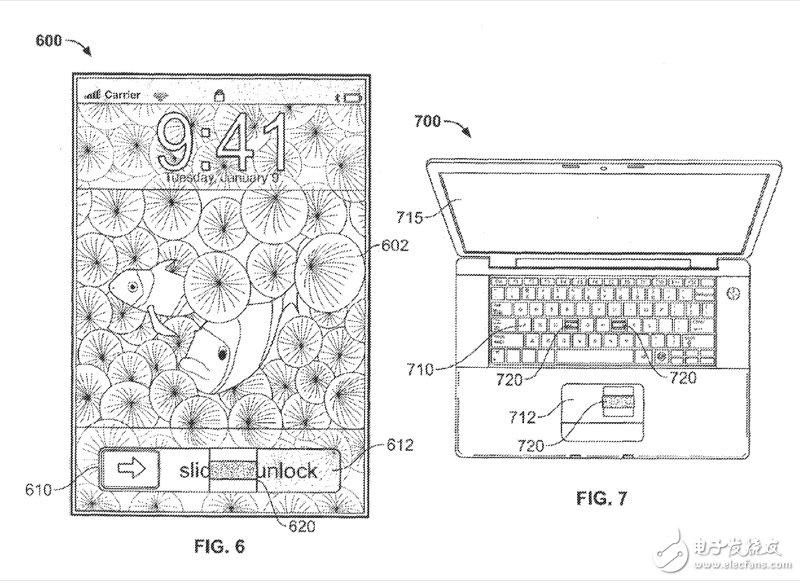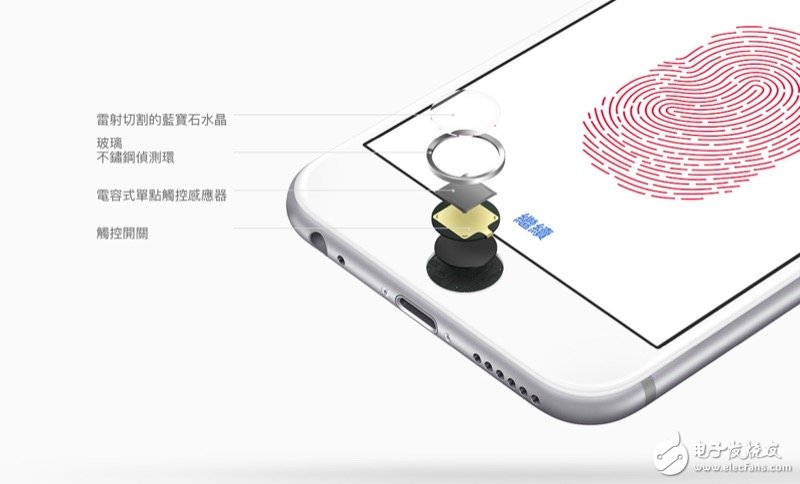A few days ago, South Korean media came out, Apple will integrate the iPhone 7 Touch ID and Home keys into the screen, embedded in the glass, and remove the physical Home button. In addition to this relatively new speculation, the current Apple Home button solution includes upgrading the Touch ID and turning it into an inductive touchpad. So, if Apple really intends to launch the Home Key 2.0, which one is more likely to be adopted?
Fingerprint recognition and screen integration are not new technologies

Eight years later, LG also released a similar technology this year, by attaching the fingerprint sensor to the bottom of the screen, and using the UI to instruct the user to press the icon on the surface of the screen to find the location corresponding to the fingerprint sensor. Then unlock. Interestingly, although the technology of integrating fingerprint sensors under the screen seems to be mature in the market, Apple's iPhone 5s released in 2013 and subsequent models with Touch ID function are not based on the original patent. Is the fingerprint identification materialized and integrated into the Home button, then, is it possible for Apple to replace the physical Home button with the virtual UI Home button and replace the Home button with the new “Little White Point†for nearly 10 years? This may be a comparison of the existing Touch ID design.
Existing Touch ID design
The existing physical Touch ID has a total of four components. In the visible part, it includes a ring of stainless steel ring that matches the color of the model. It is used as a start switch for the fingerprint sensor and sapphire covering the Home button body. Crystal can protect the underlying parts. As for the components hidden under the Home button, it includes a fingerprint sensor developed by AuthenTec (Apple acquired AuthenTec in 2012, and immediately used the product for the iPhone 5s launched every year), and the touch used to activate the Home button function. switch.
When the user puts the finger on the Home button, even if the screen has not been woken up, the outer stainless steel ring will sneak first. With the micro current of the finger, the bottom fingerprint sensor is triggered, and the electric field is activated, and then the transmission is extremely small. The current is applied to the user's finger to perform a capacitive mechanism to match the user's fingerprint.
In this process, the protective sheet of sapphire crystal has important significance. On the one hand, this piece of hardness is second only to the crystal of the diamond. It can keep the Home key flat for a long time, ensuring that the current transmission does not affect the accuracy of the fingerprint sensor due to the wear of the surface conductive layer. On the other hand, such high hardness, It also ensures that the apple can reduce the thickness of the protective layer as much as possible while maintaining the surface protection, so that the finger is closer to the fingerprint sensor, so that the AuthenTec fingerprint sensor has a weak electric field and cannot penetrate the too thick protective layer to sense the finger. The problem is that Apple uses sapphire crystal glass with a dielectric constant better than glass, and the thickness is reduced as much as possible. It is understood that the thickness of sapphire crystal covered by Apple Touch ID is less than 1mm.
Then, when the user's finger presses the Home button and wakes up the screen, since the Touch ID has been pre-identified by pressing the space before the Home button, the user will get a small illusion that the unlock response is quick, and the satisfaction is improved. degree. Interestingly, this mechanism also has a side effect - on the second-generation Touch ID, which is twice as fast (on the iPhone 6s), it unlocks the user because of the small time difference of stealing. The burden of speed is too fast.
Apple's software solution for this is to add a function that automatically wakes up the iPhone screen when you pick up the iPhone screen (A9 processor and subsequent models), allowing users to experience a complete fingerprint identification process. In addition to the experience, I also personally removed the small illusion created in order to enhance the experience and create a slower first-generation Touch ID.
Difficulties in integrating Touch ID on the screenObserving the existing Touch ID mechanism, it is not difficult to find that even if Apple intentionally changes the design and integrates fingerprint recognition on the screen, it will immediately encounter several difficulties.
First, the existing Touch ID design requires a solid metal ring to create an electric field to quickly activate the fingerprint sensor. However, the surface glass of the current iPhone screen does not have such functionality and design space. Even if Apple triggers the sensor through other technologies such as automatic wake-up on the screen, Apple has no need to exchange the new design with excess energy consumption without other obvious benefits.
The second difficulty is that in addition to the physical metal, Touch ID also needs sapphire crystal to maintain the conductive layer. If the panel is fully sapphire crystal, there is still no complete sapphire supply chain at hand to cope with the iPhone's annual shipment. The whole machine, plus Touch ID, used a sapphire crystal with a thickness of only 1mm. If the thickness of the panel is sufficient for hardness, it has a fragile problem. If you really want to make a panel, it will probably lead to more problem.
The third difficulty is that the current iPhone, in addition to the LED display, plus a full layer of capacitive sensors to measure the pressure channel of the 3D Touch, must also make room for the TapTIc Engine to create 3D Touch feedback. . The total design is unimaginable. Under the premise of continuing to thin the mobile phone, Apple will create a “Touch ID Virtualization†marketing under such a crowded screen with a prominent fingerprint sensor. Hot spot.
Removing the physical Home key is equivalent to redesigningIn addition, compared to the big move to acquire AuthenTec in the year before the launch of the iPhone 5s (total $356 million), Apple has no obvious signs to use its patented technology launched in 2008, and it is unlikely to sign a contract with LG. Ordering is only available for induction technology that is less than half a year old. At the same time, whether in hardware or software, Apple is still optimizing for the existing Touch ID solution, including the introduction of second-generation sensors, and improving the original fingerprint identification process in iOS 10.
According to the maturity of the existing Touch ID components in the supply chain, Apple's short-term suitable solution should increase shipments and reduce costs, install second-generation Touch IDs to more iOS devices, and reduce the first-generation Touch. The inventory of IDs (the iPhone SE has helped a lot), not the more difficult engineering techniques.
It's worth mentioning that although Apple has a history of polishing new technologies for a better product experience, for example, to make the Mac's FaceTIme indicator light more concealed, and the research and development results are subtle to the naked eye, the laser drilling technology is almost invisible. In addition to moving the physical Touch ID on the iPhone, it has already symbolized that Apple must deepen the industrial design of the iPhone and the user experience. For example, at the most basic level, to guide users how to unlock on the screen, a new UI solution is needed. For the visually impaired, a slightly sunken physical Home button is actually a very intuitive operation tool, which can quickly use Siri or VoiceOver. However, if you use the new virtual Home button, it means Apple must redesign. These accessibility features.
In addition, the full virtualization of the Touch ID, more related to the software level, complicates the hardware encryption that was originally paired directly with the A-series processors. How to maintain the security when encrypting, designing the iOS system failure, the unlocking scheme when the machine is down, will be a difficult problem. At the same time, if the classic design of the Home button is removed, it is also equivalent to the transformation of Apple products in the industrial design language. It is also a huge challenge for Apple designers in the post-Steve Jobs era. Overall, we believe that Apple will integrate Touch ID on the screen in a short period of time, and the opportunity should be small.
Possible new Home keyLooking back, is it possible for Apple to launch the Home Key 2.0 on the iPhone? A more likely solution for the existing design is to integrate the Home button into the 3D Touch, link the TapTIc Engine installed in the lower half of the phone, and transform the Home button into a Force Touch like the MacBook touchpad to create a vibrating The effect, if it can be simulated, the home button with a metal ring is not a physical button, it is not so important, it is currently the most feasible.
However, this function is just like 3D Touch and Force Touch. Although it has opened up space by hardware, it has extended its new orientation in operation. However, the filling of digital functions is still continuing, and even exploring, it is not particularly practical, Apple also At the same time, it faces the paradox of making the simple and practical design of the Home key more complicated. However, this may be the area where the iPhone 7 can be a surprise.
As for the Touch ID that is integrated into the touch screen in the short term, the more likely product may not be on the iPhone, but the MacBook's multi-touch panel. Perhaps Apple will give priority to the new Touch ID with multi-touch on the Mac and initially integrate the supply chain.
(Source: Flickr/KÄrlis DambrÄns CC BY 2.0)
These printer accessories are include of printer grid, Eliminator,etc.
The cartridge is irradiated by laser beam to adsorb toner, and then the toner is hot pressed by fixing roller for printing. In this process, there will be part of toner residual, which can not be "granules returned to the warehouse"; Automatic cleaning function is not adsorbed new toner particles and directly print, will remain toner away, fully ensure the next printing effect. And the Plate-Grid plays an important role. When high voltage generator to a high voltage electrode, wire electrode with reseau formed between a strong electric field, and release the corona, wire electrode and the photosensitive drum ionizes the air between the air ions migrate to the drum surface, make the photoconductor (drum) surface is full of charge, so can spare toner "adsorption to warehouse", so as to save toner, The purpose of reducing environmental pollution.
Hp Printer Tray,Hp Printer Paper Tray,Usb A Printer Cable,Printer With Paper Tray
SHAOXING HUALI ELECTRONICS CO., LTD. , https://www.cnsxhuali.com
